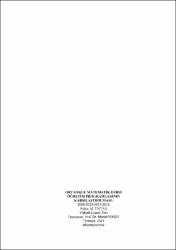| dc.contributor.author | Altıntaş Rabia | |
| dc.date.accessioned | 2019-11-26T06:52:38Z | |
| dc.date.available | 2019-11-26T06:52:38Z | |
| dc.date.issued | 2019 | en_US |
| dc.date.submitted | 2019 | |
| dc.identifier.uri | https://hdl.handle.net/11630/7301 | |
| dc.description.abstract | Bu araştırmanın amacı 2009, 2013, 2017 ve 2018 yıllarında yenilenen ve güncellenen ortaokul matematik dersi öğretim programlarının vizyonlarını, yaklaşım ve felsefelerini, amaçlarını, beceri/yetkinliklerini, değerlerini, ölçme ve değerlendirme yaklaşımlarını, öğrenme ve alt öğrenme alanlarını, kazanımlarını ve ders sürelerini karşılaştırılarak, programların benzerlik ve farklılıklarını ortaya koymaktır. Araştırmada örneklemin belirlenmesinde evreni doğru temsil etmesi açısından seçkisiz olmayan örnekleme yöntemlerinden amaçsal örneklemenin bir boyutu olan ölçüt örnekleme yöntemi kullanılmıştır. Ölçüt olarak Talim ve Terbiye Kurulu Başkanlığı tarafından basımı yapılan 2009, 2013, 2017, 2018 Ortaokul Matematik Öğretim Programları kitapçıkları baz alınmıştır. Verilerin toplanmasında doküman analizi yöntemi kullanılmıştır. Verilerin analizinde ise içerik analizi yöntemi kullanılarak veriler çözümlenmiştir. Verilerin analizi sonucunda programın vizyonu ve felsefesi için ayrı bir bölümün sadece 2009 ortaokul matematik öğretim programında bulunduğu tespit edilmiştir. Programlar felsefeleri açısından incelendiğinde ise farklılaştığı tespit edilmiştir. Genel amaçlar bakımından ise 2009, 2013 ve 2017 Ortaokul Matematik Öğretim Programları benzerlik gösterirken 2018 Ortaokul Matematik Öğretim Programında amaçların farklı bir şekilde ele alındığı tespit edilmiştir. En fazla becerinin 2009 programında yer aldığı, 2009 ve 2013 programlarının becerilerinin büyük ölçüde benzerlik gösterdiği ve becerilerin sadeleştirilip en temel becerilerin 2017 ve 2018 programlarında yer aldığı sonucuna ulaşılmıştır. 2017 ve 2018 öğretim programlarında ilk kez değerler kavramından bahsedildiği sonucuna ulaşılmıştır. Yetkinlik bölümünün ilk kez 2018 öğretim programında yer aldığı saptanmıştır. Programlar öğrenme alanları bakımından ele alındığında ise her birinin 5 öğrenme alanına sahip olduğu fakat isimlerinde bazı değişiklikler olduğu belirlenmiştir. Kazanım sayılarının git gide azalırken, ders sürelerinin arttığı tespit edilmiş ve dört programda da hem süreç hem sonuç odaklı değerlendirme anlayışı olduğu saptanmıştır. | en_US |
| dc.description.abstract | The aim of this research is to reveal the similarities and differences of the secondary school mathematics curricula restored and updated in 2009, 2013, 2017 and 2018 through comparison of their visions, approaches, philosophies, objectives, abilities/skills, values, learning domains and sub domains, learning outcomes and course times. In the study, the criterion sampling method, which is purposeful sampling of the non-random sampling methods, was used in order to represent the population correctly. The criterion was based on 2009, 2013, 2017 and 2018 mathematics secondary school curriculum booklets published by The Head Council of Education and Morality. Document analysis method was used as data collection method. The data were analyzed using content analysis method. As a result of the data analysis, it was determined that a separate section for the vision and philosophy of the program was found only in the 2009 secondary school mathematics curriculum. In terms of philosophy, the curricula were found to have differentiated. In terms of general objectives, 2009, 2013 and 2017 secondary school mathematics curricula were similar, but the objectives were handled differently in the 2018 curriculum. It was seen that the most skills existed in the curriculum of 2009, that the basic skills in the curricula of 2009 and 2013 were mostly similar and that skills were simplified and the most basic ones were included in the curricula of 2017 and 2018. It was also determined that the concept of values was mentioned for the first time in the 2017 and 2018 curricula. The competency section was included in the 2018 curriculum for the first time. In terms of learning domains, it was found that each had 5 learning domains but with some differences in their names. It was found that while the number of learning outcomes gradually decreased, the course hours increased and the four curricula had an understanding of both process and result oriented evaluation. | en_US |
| dc.language.iso | tur | en_US |
| dc.publisher | Afyon Kocatepe Üniversitesi Sosyal Bilimler Enstitüsü | en_US |
| dc.rights | info:eu-repo/semantics/openAccess | en_US |
| dc.subject | Ortaokul matematik dersi | en_US |
| dc.subject | öğretim programı | en_US |
| dc.subject | karşılaştırma | en_US |
| dc.title | Ortaokul matematik dersi öğretim programlarının karşılaştırılması: 2009-2013-2017-2018 | en_US |
| dc.title.alternative | Comparision of secondary school mathematics curriculums: 2009-2013-2017-2018 | en_US |
| dc.type | masterThesis | en_US |
| dc.department | Sosyal Bilimler Enstitüsü | en_US |
| dc.relation.publicationcategory | Tez | en_US |
| dc.contributor.institutionauthor | Altıntaş, Rabia | |



















